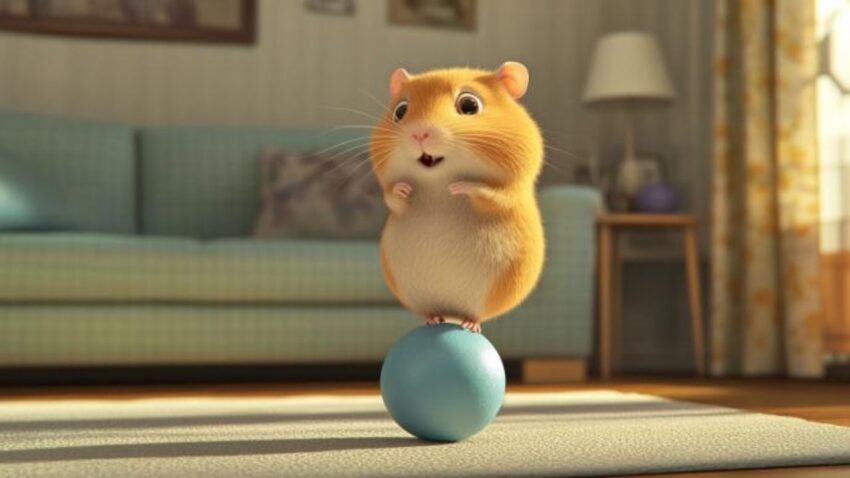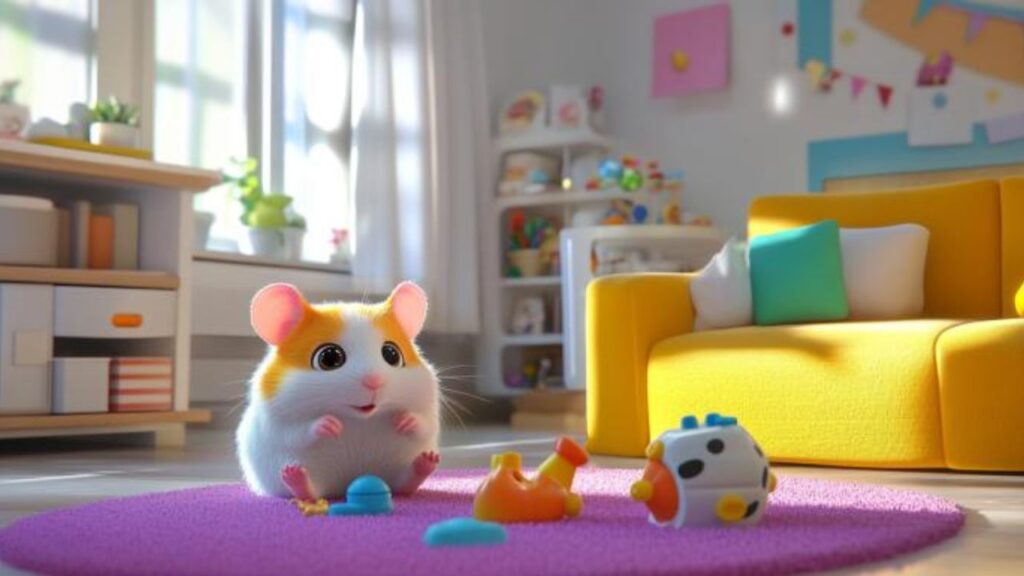Hello, hamster enthusiasts! Whether you’re a seasoned hamster owner or a newbie to the world of these adorable pets, there’s always something exciting to learn and teach. Today, we’re diving into a particularly fun and rewarding activity: training your hamster to balance on a small ball. This might sound like a circus trick, but with patience and the right approach, your tiny acrobat can master this skill, adding an entertaining routine to their repertoire and enhancing your bond with them.
Importance of Teaching Hamsters New Tricks
You might wonder, why bother teaching a hamster to balance on a ball? Teaching your hamster new tricks is not just about showing off to friends and family (though that’s definitely a bonus!). It’s about providing mental stimulation and physical exercise, which are crucial for a hamster’s overall well-being. These intelligent little creatures thrive on challenges and new experiences, and trick training is a great way to keep their minds sharp and their bodies active.
Overview of the Benefits for Both Hamsters and Owners
Training your hamster to balance on a small ball offers a multitude of benefits. For your hamster, the advantages include:
- Mental Stimulation: Learning new tricks engages your hamster’s brain, helping to prevent boredom and related behaviors such as chewing on cage bars.
- Physical Exercise: Balancing on a ball is a great workout, improving your hamster’s coordination and muscle strength.
- Confidence Building: Successfully learning a new trick can boost your hamster’s confidence and willingness to explore other new activities.
For you, the owner, the benefits are equally rewarding:
- Bonding: Training sessions are a fantastic opportunity to bond with your hamster, building trust and affection.
- Entertainment: Watching your hamster learn and perform tricks is incredibly entertaining and fulfilling.
- Skill Development: You’ll develop patience and creativity as you figure out the best ways to teach and motivate your hamster.
In this guide, we’ll cover everything you need to know to get started, from selecting the right ball to step-by-step training methods, and even some advanced tricks to keep things interesting. So, let’s roll into this exciting journey of training your hamster to balance on a small ball!
Selecting the Right Ball
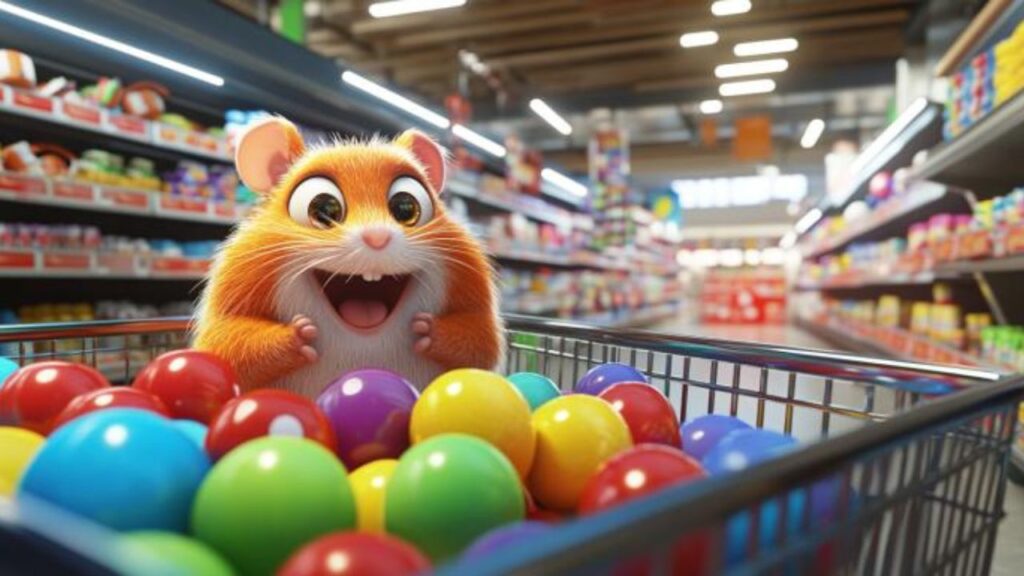
Ball Features
When it comes to training your hamster to balance on a ball, selecting the right ball is crucial for both safety and effectiveness. The ball should be made of durable, non-toxic materials. Avoid balls with small parts that could be chewed off and swallowed, as well as those made of hard plastic that might be too slippery for your hamster to grip. Instead, opt for materials like rubber or soft plastic that provide some traction and are gentle on your hamster’s paws.
Additionally, ensure the ball has a textured surface. A smooth ball might be too challenging for your hamster to balance on initially. Textures help provide the necessary grip, making it easier for your hamster to get a foothold and feel secure while learning to balance.
Size and Stability Suitable for Hamsters
The size of the ball is equally important. For dwarf hamsters, a smaller ball with a diameter of around 2-3 inches is appropriate, while Syrian hamsters might need a slightly larger ball, around 4-5 inches in diameter. The ball should be large enough to support your hamster’s body comfortably but not so large that it becomes difficult for them to manage.
Stability is another critical factor. Choose a ball that doesn’t roll too easily, especially during the initial training phases. Some balls come with a flat base or a stand that can prevent excessive rolling. As your hamster gets better at balancing, you can gradually introduce more movement by using a ball that rolls more freely.
Preparing the Ball
To make the ball inviting, start by familiarizing it with your hamster’s environment. Rub the ball with some of your hamster’s bedding or place it in their cage for a few days. This will transfer their scent onto the ball, making it a familiar object rather than a foreign one. You can also sprinkle a little bit of their favorite treat on the ball to pique their interest.
Initial Introduction in a Familiar Environment
Introduce the ball in a setting where your hamster feels safe and comfortable, such as their playpen or a familiar corner of their cage. Place the ball on a stable surface and allow your hamster to explore it at their own pace. Sit quietly nearby and observe their reactions. At this stage, you’re not looking for them to balance yet; the goal is simply to get them accustomed to the ball’s presence.
Encourage your hamster to interact with the ball by placing treats around it and on top of it. Positive reinforcement is key here. When your hamster shows interest in the ball—sniffing it, touching it, or climbing on it—reward them with praise and a small treat. This helps create positive associations with the ball, making them more willing to engage with it during training.
Understanding Hamster Behavior

Natural Instincts
Hamsters are naturally curious creatures, driven by their instincts to explore their environment. When a new object, like a ball, is introduced into their space, they will typically start by cautiously sniffing and nibbling it. This exploratory behavior helps them gather information and assess whether the new object is safe. Hamsters use their whiskers and sensitive noses to investigate new items, often followed by tentative touches with their paws.
Observing how your hamster reacts to new objects can provide valuable insights into their comfort levels. For instance, a confident hamster might climb onto the ball relatively quickly, while a more timid hamster may take its time, gradually getting closer as it builds confidence.
Scientific Insights into Hamster Balance and Motor Skills
Understanding the scientific basis of hamster motor skills can enhance your training efforts. Hamsters have a strong sense of balance, which they develop naturally in the wild while navigating uneven terrains and climbing structures. This balance is crucial for various activities, including running on wheels and climbing tubes.
Studies have shown that hamsters have excellent proprioception—the ability to sense the position and movement of their bodies. This sense helps them adjust their posture and movements to maintain balance. By leveraging their natural balance and motor skills, you can effectively teach your hamster to perform tricks like balancing on a ball.
Comfort and Stress Signals
Hamsters communicate a lot through their body language, and recognizing these signals can help you ensure their well-being during training. Signs of comfort and curiosity include:
- Exploring: Sniffing, nibbling, and climbing on the ball.
- Grooming: A relaxed hamster might groom itself near the ball, indicating it feels safe.
- Active Movement: Walking around and interacting with the ball confidently.
Conversely, signs of stress or discomfort include:
- Freezing: A stressed hamster may freeze in place, unsure of how to proceed.
- Hiding: Retreating to a corner or hiding in a shelter indicates fear.
- Aggression: Biting or chattering teeth are signs of anxiety or displeasure.
- Rapid Breathing: Fast, shallow breathing can be a sign of stress.
By closely observing these cues, you can gauge your hamster’s comfort level and adjust the training process accordingly.
Creating a Stress-Free Training Environment
Creating a stress-free environment is essential for successful training. Here are some tips to ensure your hamster feels safe and comfortable:
- Familiar Surroundings: Conduct training sessions in a familiar and secure area where your hamster feels at ease.
- Quiet Environment: Reduce noise and other disturbances during training to prevent startling your hamster.
- Gradual Introduction: Introduce new elements slowly, allowing your hamster time to adjust. Start with the ball being stationary before progressing to more challenging tasks.
- Short Sessions: Keep training sessions brief, around 5-10 minutes, to avoid overwhelming your hamster.
- Positive Reinforcement: Use treats and gentle praise to reward your hamster’s positive interactions with the ball. This reinforces good behavior and builds trust.
Step-by-Step Training Process
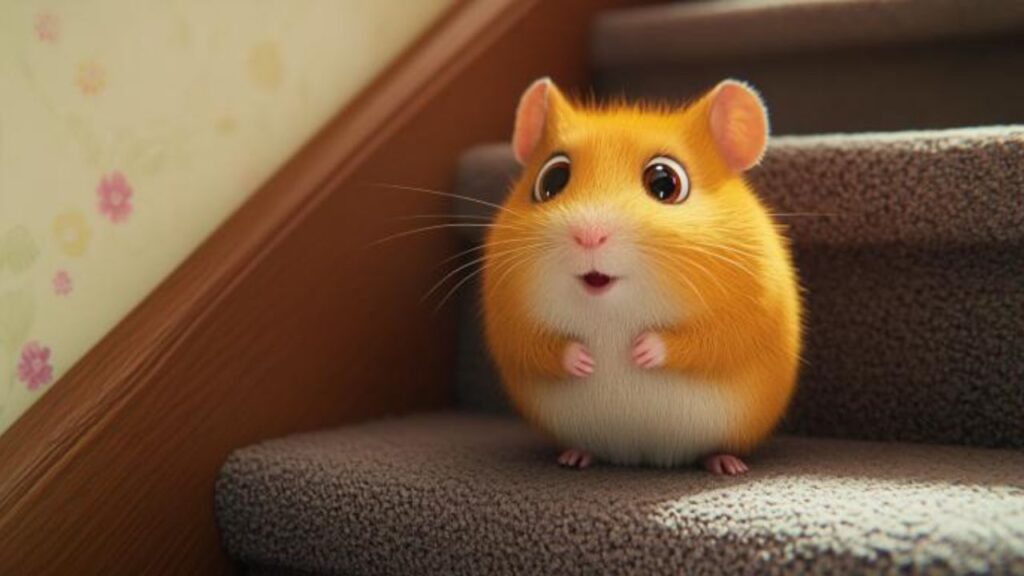
Initial Interaction
The first step in training your hamster to balance on a small ball is to get them comfortable with it. Place the ball in a familiar play area where your hamster feels safe. Allow your hamster to explore the ball at their own pace. Initially, they might sniff or paw at the ball, which is a good sign of curiosity.
To encourage your hamster to approach and interact with the ball, scatter some of their favorite treats around it and on top of it. Use small, hamster-safe treats like sunflower seeds or tiny pieces of fruit. The treats will draw your hamster closer to the ball and help them associate it with positive experiences.
As your hamster begins to touch and explore the ball, offer verbal praise in a calm, soothing voice. This positive reinforcement helps your hamster feel secure and reinforces the idea that the ball is a safe and rewarding object.
Using Treats to Create Positive Associations
Treats play a crucial role in creating positive associations with the ball. Each time your hamster touches or climbs onto the ball, reward them with a small treat. Start by placing treats around the base of the ball, gradually moving them to the top as your hamster becomes more confident.
Consistency is key. Repeat this process several times a day, ensuring each interaction with the ball is followed by a reward. Over time, your hamster will begin to see the ball as a source of treats and positive experiences, making them more willing to engage with it.
Balancing on the Ball
Once your hamster is comfortable interacting with the ball, it’s time to encourage them to climb onto it. Start by placing a treat on top of the ball, close to the edge. This placement makes it easier for your hamster to reach the treat without feeling unsteady.
Gently guide your hamster towards the ball using your hand or a small ramp. If your hamster hesitates, give them time to explore and adjust. Never force your hamster onto the ball, as this can create negative associations and increase stress.
If your hamster climbs onto the ball but quickly jumps off, remain patient and offer reassurance. Place your hand near the ball to provide additional support and stability, helping your hamster feel more secure as they attempt to balance.
Patience and Persistence Tips
Training a hamster to balance on a ball requires patience and persistence. Each hamster learns at their own pace, so it’s important to remain calm and encouraging throughout the process. Keep training sessions short, around 5-10 minutes, to maintain your hamster’s interest and prevent them from becoming overwhelmed.
Celebrate small victories, such as your hamster touching the ball or standing on it momentarily. These incremental successes build your hamster’s confidence and reinforce positive behavior. Consistency is key—regular, brief training sessions are more effective than infrequent, longer ones.
Maintaining Balance
Once your hamster is comfortable climbing onto the ball, you can begin introducing gentle movements to help them maintain balance. Start by placing the ball on a stable surface that allows for slight rocking motions. Use your hand to gently tilt the ball back and forth, helping your hamster adjust to the sensation of movement.
Observe your hamster’s reactions closely. If they appear comfortable and curious, continue with gentle movements. If they seem stressed or try to jump off, stop immediately and give them time to regain their composure. Always prioritize your hamster’s comfort and well-being during training.
Gradually Increasing the Difficulty
As your hamster becomes more skilled at balancing on the ball, you can gradually increase the difficulty of the movements. Begin by slightly rolling the ball back and forth, encouraging your hamster to adjust their balance. Use treats and verbal praise to reward your hamster for staying on the ball and maintaining their balance.
Over time, you can introduce more complex movements, such as gentle spins or tilting the ball at different angles. Always proceed gradually, ensuring each new challenge is introduced in a way that builds your hamster’s confidence rather than causing stress.
Overcoming Challenges

Common Training Obstacles
It’s not uncommon for hamsters to exhibit fear or reluctance when introduced to new activities like balancing on a ball. Understanding and addressing these reactions is crucial for successful training. Hamsters are naturally cautious and may initially perceive the ball as a threat.
To address fear or reluctance:
- Gradual Exposure: Start by placing the ball in your hamster’s environment without any expectation for interaction. Allow them to explore it at their own pace.
- Positive Reinforcement: Use treats and praise to create positive associations with the ball. Reward your hamster for any interaction, no matter how small.
- Safe Environment: Ensure that the training area is quiet and free from sudden noises or movements that could startle your hamster.
If your hamster seems particularly fearful, take a step back and slow down the process. Allow them to build confidence over time without pressure.
Solutions for Common Issues
- Ignoring the Ball: If your hamster shows no interest in the ball, try using more enticing treats or changing the location of the training sessions. Sometimes a new environment can spark curiosity.
- Jumping Off the Ball: If your hamster jumps off as soon as they get on, ensure the ball is stable and not rolling too much. Start with a stationary ball and gradually introduce movement.
- Chewing on the Ball: If your hamster starts chewing on the ball, ensure it’s made from safe, non-toxic materials. Redirect their chewing behavior with appropriate chew toys placed nearby.
When to Take a Break
Training can be exhausting for hamsters, both mentally and physically. It’s essential to recognize signs that your hamster needs a break:
- Excessive Grooming: A stressed hamster may groom themselves more than usual.
- Hiding: If your hamster retreats to a corner or hideout, it’s a clear sign they need a rest.
- Aggressive Behavior: Biting or chattering teeth indicates anxiety or frustration.
- Rapid Breathing: Fast, shallow breathing is a sign of stress.
When you notice any of these signs, stop the training session immediately. Allow your hamster to rest in a familiar, comfortable space. Provide fresh water and a cozy place to sleep.
Importance of Not Over-Stressing Your Pet
Over-stressing your hamster can lead to health issues and negatively impact their willingness to participate in future training. Keep sessions short, around 5-10 minutes, and always end on a positive note. This helps maintain your hamster’s interest and ensures they look forward to training.
Consistency and Patience
Consistency is key to successful training. Establish a regular schedule, ideally training at the same time each day. Hamsters thrive on routine, and a consistent schedule helps them know what to expect and feel secure. Regular, brief sessions are more effective than infrequent, longer ones.
Keep track of your training sessions in a journal. Note what works, what doesn’t, and any progress your hamster makes. This record can help you adjust your approach and see the improvements over time.
Celebrating Small Victories
Training your hamster is a journey filled with small milestones. Celebrate every little achievement, whether it’s your hamster touching the ball, climbing onto it, or balancing for a few seconds. Positive reinforcement through treats and praise is crucial for reinforcing good behavior.
Remember, each small step is a building block towards the final goal. By celebrating these victories, you boost your hamster’s confidence and motivation to continue learning.
Encouragement and Motivation for Both Hamster and Owner
- Stay Positive: Maintain a positive attitude, even if progress seems slow. Your hamster can sense your mood, and a calm, encouraging demeanor will help them feel secure.
- Journaling: Keep a training journal to track your hamster’s progress, noting what works and what doesn’t. This can be a great motivational tool and help you adjust your training strategies.
- Support Network: Connect with other hamster owners for tips and encouragement. Sharing experiences can provide new insights and keep you motivated.
- Patience is Key: Remember that every hamster learns at their own pace. Patience and consistency are your best allies in successful training.
Fun Variations and Advanced Tricks
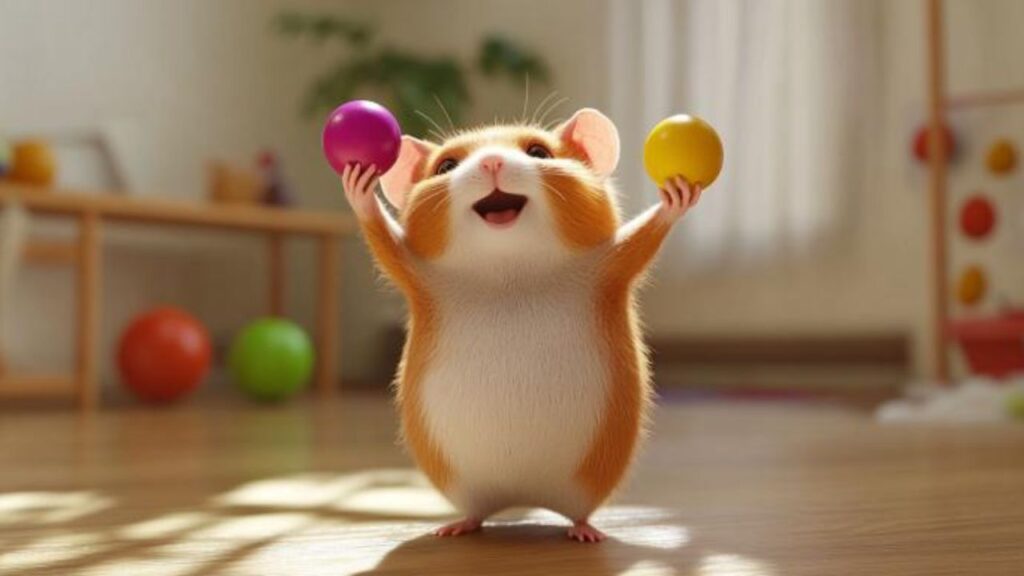
Introducing New Challenges
Once your hamster has mastered the basics of balancing on the ball, you can introduce new challenges to keep them engaged and entertained. One way to do this is by adding obstacles around the ball or incorporating it into a larger play area. Create a small obstacle course with tunnels, ramps, and platforms that your hamster must navigate to reach the ball. This setup not only makes the activity more engaging but also provides additional physical and mental stimulation.
For instance, you can place a series of small ramps leading up to the ball, encouraging your hamster to climb and balance. Alternatively, you can set up a series of tunnels that lead to the ball, making the journey to the ball an adventure in itself. This variation keeps the training sessions dynamic and prevents your hamster from becoming bored with repetitive tasks.
Making the Trick Part of a Performance Routine
Transforming the ball-balancing trick into a part of a performance routine can add an element of fun and excitement. You can create a mini circus act where your hamster performs a series of tricks, with balancing on the ball as the grand finale. Start with simpler tricks like running through a tunnel or climbing a small ladder, gradually leading up to the ball-balancing act.
Incorporate a sequence of actions that build anticipation, such as running through a tunnel, jumping over a small obstacle, and finally climbing onto the ball. Use treats and verbal praise to guide your hamster through each step of the routine. With practice, your hamster will learn to perform the entire sequence smoothly, providing an entertaining show for you and your friends.
Group Training Sessions
If you have more than one hamster or can arrange playdates with other hamster owners, supervised group training sessions can be a delightful way to socialize your pets while teaching them new tricks. However, it’s important to ensure that all hamsters involved are comfortable with each other and the training environment.
Start by allowing the hamsters to interact in a neutral space with plenty of hiding spots and escape routes. Observe their behavior closely to ensure there is no aggression or stress. Once they are comfortable together, introduce the ball and other training props. Group sessions can foster a sense of competition and mimicry, where hamsters learn by watching each other.
Rotate the hamsters, giving each one a turn to practice balancing on the ball while the others watch. This setup encourages positive interactions and can make training sessions more dynamic and engaging.
Ensuring Safe and Positive Interactions
Safety is paramount during group training sessions. Ensure the training area is spacious enough for all hamsters to move freely without feeling cramped. Provide multiple balls and training props to minimize competition and potential conflicts.
Always supervise the sessions closely. If any hamster shows signs of stress or aggression, separate them immediately and provide a calm environment to cool down. By managing the interactions carefully, you can create a positive and enriching experience for all the hamsters involved.
Advanced Ball Tricks
Once your hamster is confident balancing on the ball, you can introduce more advanced tricks like spins and rolls. Start by gently rolling the ball while your hamster is on it, encouraging them to adjust their balance. Use treats and praise to reward them for staying on the ball and adapting to the movement.
For spins, guide your hamster to move in a circular pattern on top of the ball. You can do this by holding a treat slightly out of reach and moving it in a circular motion, prompting your hamster to follow the treat and spin on the ball. This trick requires patience and practice, but with consistent training, your hamster will learn to perform spins smoothly.
Using Clicker Training for Precision
Clicker training can be an effective method for teaching precise and complex tricks. A clicker is a small device that makes a clicking sound when pressed, which you use to mark the exact moment your hamster performs the desired behavior. Pair the clicking sound with a treat to reinforce the behavior.
Start by clicking and treating when your hamster interacts with the ball. Gradually increase the criteria, clicking only when your hamster performs specific actions like spins or staying balanced on a rolling ball. The clicker helps your hamster understand exactly which behavior is being rewarded, making the training process clearer and more efficient.
Clicker training requires consistency and timing, but it can significantly enhance your hamster’s ability to learn advanced tricks. With practice, your hamster will become more responsive to the clicker and more adept at performing complex behaviors.
Hannah’s Training Tactics

Quick Tips for Ball-Balancing Success
- Start Small: Begin with a stationary ball on a stable surface to help your hamster get used to balancing without the added challenge of movement.
- Use High-Value Treats: Find out what treats your hamster loves the most—such as small pieces of apple or sunflower seeds—and use these to encourage them to interact with the ball.
- Positive Reinforcement: Reward your hamster immediately after they touch or climb onto the ball. This helps create a strong association between the ball and positive experiences.
- Gradual Progression: Increase the difficulty gradually. Start with simple tasks like touching the ball, then move on to climbing and balancing.
- Short Sessions: Keep training sessions brief, around 5-10 minutes, to maintain your hamster’s interest and prevent them from becoming overwhelmed.
- Consistent Schedule: Train at the same time each day to establish a routine. Hamsters thrive on consistency and predictability.
- Gentle Guidance: Use your hand to provide support and guide your hamster onto the ball if needed. Always be gentle and patient.
Tips on Keeping Training Sessions Fun and Engaging
- Incorporate Play: Turn training into a game by creating small obstacle courses that lead to the ball. This keeps your hamster mentally stimulated and makes the process more enjoyable.
- Rotate Toys: Keep things interesting by rotating the toys and obstacles around the ball. This prevents boredom and keeps your hamster curious.
- Interactive Toys: Use puzzle feeders or chew toys near the ball to keep your hamster engaged and encourage exploration.
- Bonding Time: Use training sessions as an opportunity to bond with your hamster. Offer gentle petting and verbal praise to strengthen your connection.
- Variety: Mix up the training tasks to keep sessions dynamic. Introduce new challenges and tricks regularly to maintain your hamster’s interest.
Troubleshooting Common Problems
- Hamster Ignoring the Ball:
- Solution: Change the placement of the ball or try using different high-value treats. Sometimes a new location or a different treat can spark your hamster’s interest.
- Fear or Reluctance:
- Solution: Move the ball further away and slowly bring it closer over several days. Place treats leading up to and inside the ball to create a positive association.
- Jumping Off Quickly:
- Solution: Ensure the ball is stable and not rolling too much. Start with a stationary ball and gradually introduce movement as your hamster becomes more confident.
- Chewing on the Ball:
- Solution: Add chew toys near the ball to provide an appropriate outlet for this behavior. Ensure the ball is made of safe, non-toxic materials.
Encouragement and Motivation for Both Hamster and Owner
- Celebrate Small Wins: Every little progress is a victory. Celebrate each time your hamster gets closer to balancing on the ball, no matter how small the step.
- Stay Positive: Maintain a positive attitude, even if progress seems slow. Your hamster can sense your mood, and a calm, encouraging demeanor will help them feel secure.
- Journaling: Keep a training journal to track your hamster’s progress, noting what works and what doesn’t. This can be a great motivational tool and help you adjust your training strategies.
- Support Network: Connect with other hamster owners for tips and encouragement. Sharing experiences can provide new insights and keep you motivated.
- Patience is Key: Remember that every hamster learns at their own pace. Patience and consistency are your best allies in successful training.
Conclusion

Recap of the Training Journey
Congratulations on taking the first steps toward teaching your hamster to balance on a small ball! This training journey has been both a fun and enriching experience for you and your furry friend. We started by selecting the right ball, focusing on safety and suitability. Then, we delved into understanding hamster behavior, learning how to recognize signs of comfort and stress to create a supportive training environment.
Step by step, we guided your hamster from initial interactions with the ball to mastering the art of balancing. Along the way, we tackled common challenges, providing practical solutions to overcome obstacles such as fear or reluctance. We also explored advanced tricks and fun variations to keep the training dynamic and engaging. Through “Hannah’s Training Tactics,” you received quick tips and actionable advice to make each session successful.
Emphasizing the Importance of Patience and Fun in Training
The key to successful hamster training lies in patience and making the process enjoyable. Every hamster learns at their own pace, and it’s important to respect their individual progress. By remaining calm and positive, you help your hamster build confidence and trust, creating a strong bond between you.
Training should never feel like a chore. Instead, view it as a series of playful interactions that bring joy and enrichment to your hamster’s life. Celebrate small victories and appreciate the journey as much as the destination. The more fun you have together, the more rewarding the experience will be for both of you.
Encouragement to Continue Exploring New Tricks and Activities
Balancing on a ball is just the beginning. There are countless other tricks and activities you can explore with your hamster. Teaching new behaviors keeps your hamster mentally and physically stimulated, ensuring they remain happy and healthy. Consider introducing agility courses, teaching your hamster to respond to their name, or even performing simple tricks like spinning or standing on their hind legs.
Each new trick not only provides additional enrichment but also strengthens the bond between you and your hamster. Keep sessions short, positive, and varied to maintain your hamster’s interest. Remember, the goal is to create a fun and engaging environment where your hamster can thrive.
With paws and patience, you’re on the road to being a Hamster Whisperer. Happy training!

